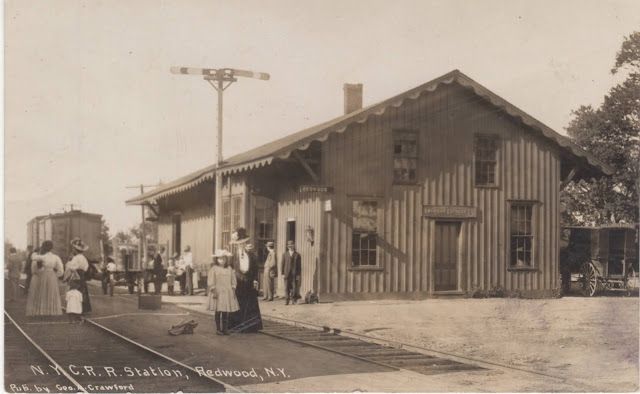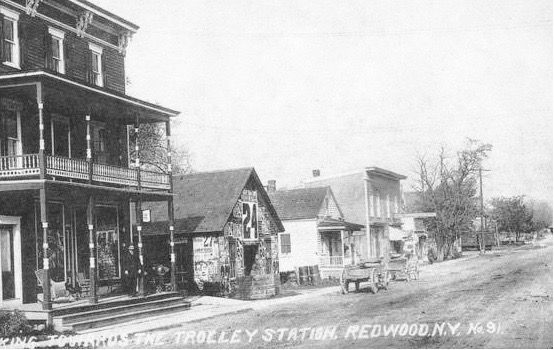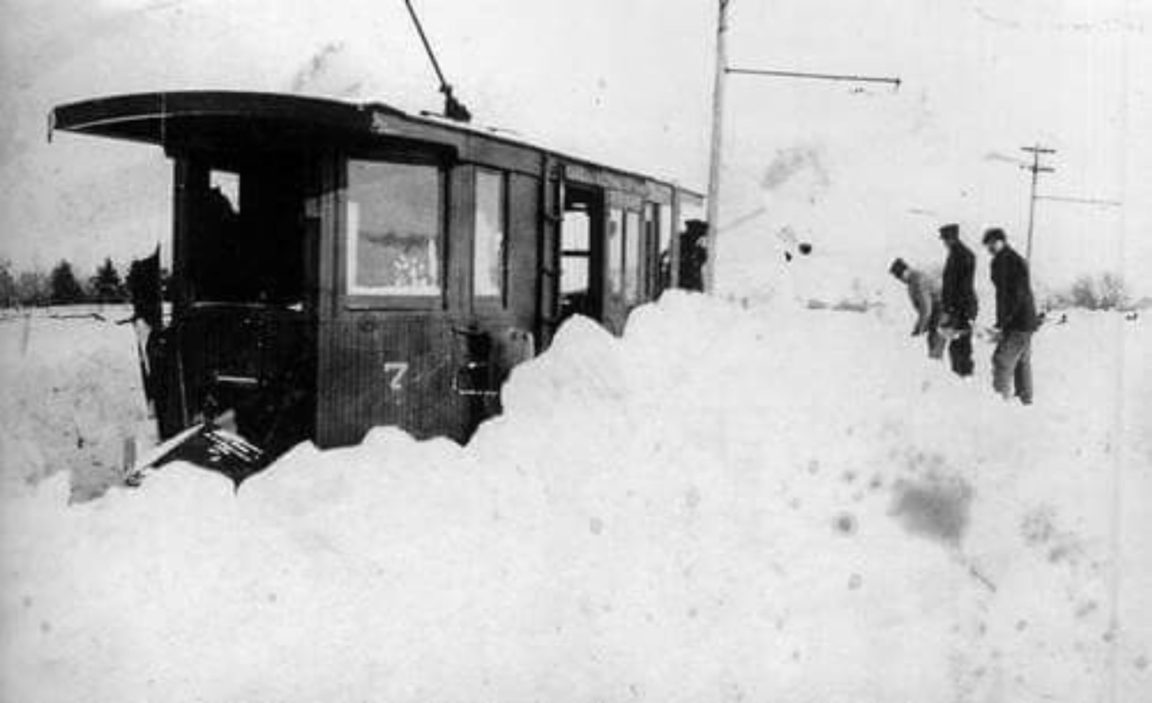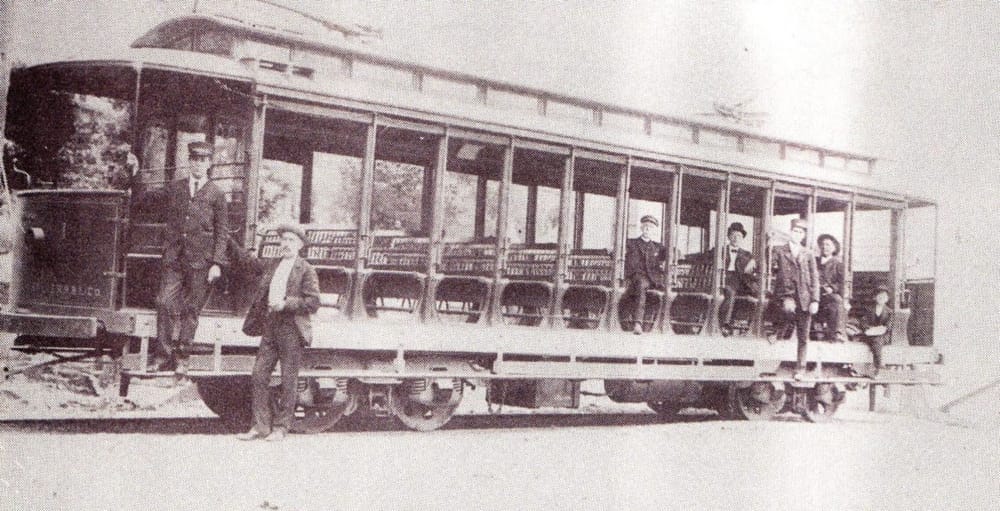Taking the Trolley to Alexandria Bay
by: Richard Palmer
One of the first electric trolley lines in northern New York was a line built from Redwood, near the New York Central Railroad station, to the village of Alexandria Bay. It was only seven and a half miles long and was built by a group of local investors, who organized themselves as the St. Lawrence International Electric Railroad and Land Company.

The New York Central Railroad, in this region known as the “Hojack,” (formerly the Rome, Watertown & Ogdensburg) operated branches to Clayton and Cape Vincent, but none to Alexandria Bay. Until the trolley line was built, people bound for Alexandria Bay had to detrain at Redwood and travel aboard carriages to their destination.
The trolley company was incorporated on February 6, 1900 and secured a franchise to construct their rail line. It was financially backed by Charles H. Remington and B. B. Taggart of Watertown, and Jacob Amos of Baldwinsville. Construction of the seven and a half-mile line, consisting of a single track with three switches, proceeded rapidly. A power plant was built on Otter Street in Alexandria Bay, to house the coal-fired generating system. It began business with two open cars and one coach, each 45 feet long. The open cars had 15 benches and each was equipped with four 37-horsepower electric motors.
We can thank Mina Herrick King, who captured part of the history in her 1990 book, “Things I Remember”. She related that the first run was made on Sunday evening, August 18, 1902. According to news reports, “Many waited anxiously to see it start. A large number enjoyed a free ride.”
The running time over the line was 24 minutes. Initially during the summer, the trolley made the round trip every 90 minutes. Electric power was furnished by the coal-fired generating station located on Otter Street. It was a great event when the first trolley clanged its way down Church Street and stopped in front of the company’s office on Market Street.


It was the intent of the company to build a connection at Redwood to bring regular railroad passenger cars to Alexandria Bay. A spur was laid in Redwood for this purpose, but this connection was never made. It began business with three cars with a fourth car added later. On busy summer days, and during special events, 800 to 1,000 people a day might come by trolley on a weekend.
Beside operating the trolley line, the company provided electricity to Alexandria Bay. The company’s office was located on Market Street and the car barn was off Otter Street. In the village, the trolley line ran through the business district on Market, James, and Church streets. There were three turnouts to allow cars to pass each other or serve businesses. Trolleys originally made the one-way trip in about 24 minutes. The trolley met all New York Central passenger trains stopping at Redwood, with freight, express, and mail service provided. In 1903, there was considerable discussion of extending the trolley line to Watertown, but this never occurred. The Alexandria Bay village board granted the trolley line permission to extend its line from the upper to the lower bay, to docks to be built.
Only two daily round trips were made during the winter – and frequently none at all, when the line was snowed in for days at a time. The Norwood News on April 12, 1904 reported: “The Redwood and Alexandria Bay trolley line has been thawed out and is now running after a rest of about two and a half months.” In the winter, trolleys halted at the top of Church Street hill rather than proceed down the steep grade.

Winter weather was always a problem; The Ogdensburg Daily News reported on March 25, 1905:
“The Alexandria Bay trolley people are out with a proposition to open the road providing enough men will volunteer to clear the snow from the tracks and take tickets for their pay. After everything is made ready at these terms, the company will carry passengers between Redwood and the Bay at something like 10 cents a mile.
In other words, the sooner the Bay people will shovel snow for store pay the quicker will the company be ready to charge 50 cents for a 25-cent trip. Moral: “Don’t buy a trolley road unless you are possessed of a reasonable amount of gall.”
The first motorman was Patrick Gallagher of Watertown, and the first conductor was William Grappote of Redwood. Later, Gallagher became the superintendent. Other conductors and motormen over the years included Howard Scott, Michael Cobey, Frank Hess, Mary Sibley, C. R. and Fred Springer. The last superintendent was Herbert D. Martin, who continued as such until the line was abandoned.
A brochure promoting the Thousand Islands, published about 1912, noted:
“When you travel by this route, you board a New York Central train to Redwood, a tiny dot on the map, and from there take a trolley to Alexandria Bay. A trip down the St. Lawrence in a swift motorboat or a stately, luxurious yacht is ideal. Motor boating, yachting, playing tennis and polo occupy a great portion of the time of the society contingent at the Thousand Islands.”
In its formative years, before automobiles and improved roads, the trolley line did an enormous business in both passenger and freight. But this soon gave way to improved highways. Bus service between Redwood and Alexandria Bay hastened its demise. Even the bus eventually faded away, as people now had automobiles. An inspector for the New York State Public Transportation in 1907 found the trolley line in deplorable condition. The trolley cars were run down and in need of painting and repairs. The tracks had taken on a “ripple effect,” and cars wobbled down the line dangerously.
The line finally ceased operations late in 1916 and its property was sold for junk. The electrical generation portion of the business was sold to Northern New York Utilities, which eventually became the Niagara Mohawk Power Corporation.
[Header photograph courtesy Alexandria Township Historical Society]
By Richard Palmer
Richard F. Palmer is a retired newspaper editor and reporter, and he was well known for his weekly historical columns for the “Oswego Palladium-Times,” called "On the Waterfront." His first article for TI Life was written in January 2015, and since then, he has written a dozen-plus others. He is a voracious researcher, and TI Life readers benefit from his interesting findings. Click here to see some of Richard Palmer’s TI Life Articles or here.
Editor's note: Once this article was complete the author, Richard, suggested I add this photograph thinking it will bring back more memories. I agree!







Please click here if you are unable to post your comment.